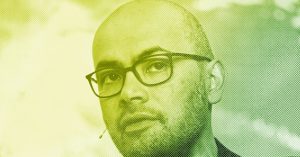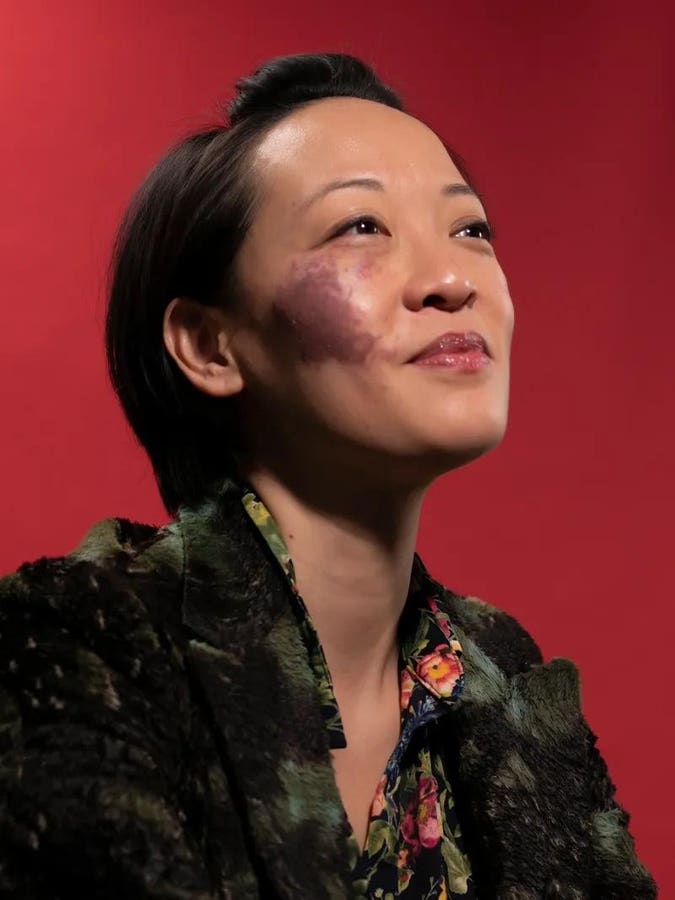Liz Sargent grew up in a Chicago suburb with her adoptive parents who had four biological children, and seven adopted children. The youngest of the blended brood of eleven is Anna, who is the central character in Sargent’s short film Take Me Home. The film, which has shown at more than 28 festivals including SXSW and Sundance, tells the story of Sargent’s lived experiences with adoption, disability, and family. In addition to the short film, a feature-length version in currently in development, with the story going deeper (and longer) on Anna’s journey as a disabled person as she “faces an impossible ableist world and struggles to balance independence with her dreams.”
A trailer for Take Me Home is available on the film’s website; the full, almost 16-minute affair is available on Vimeo. The film also is included in Delta Airlines’ in-flight entertainment through December.
Sargent, who was adopted from Korea, called her childhood in a recent interview with me “magical” because she grew up amongst this “eclectic family where everyone was the same because everyone was different.” She went to school to study modern dance, eventually working in New York City in experimental theater for a while. It was in New York, along with her husband, that Sargent came to grips with the realization she had a desire to tell stories which were “really intimate and personal and human rather than super esoteric [and] modern.”
As to what led her to make Take Me Home, Sargent told me she storytelling has long been a way for her to “understand these really intense, harrowing emotional conversations that are too frightening for me to confront in real life.” Sargent writes a lot about the future, out of fear over what will happen to her family. She described herself as “overcome with anxiety” as an adult thinking about what will happen after her parents pass away. Moreover, Sargent said she often ruminates over what responsibilities she has to her family and how to navigate the myriad systems in place for disabled people—all the while managing her own independence and the hopes and dreams she has for her life.
“When I started writing the story [of Take Me Home], it felt like it was centered on the struggle of the non-disabled sibling,” Sargent said. “She was heroic with this big visionary heart, and I realized it didn’t really work until I figured out that Anna is the hero just as she is. Her point of view is the untold story. That’s when it all clicked together.”
When asked about the technological aspects of the film, Sargent said Take Me Home is “really a family film.” Her husband and one of her sisters both are given producer credits. The film was shot in her parents’ house, with Sargent’s mom playing herself. The film was set up from beginning to end in such a way, Sargent told me, to enable Anna to “create a super authentic performance.” Sargent noted setting up production for shooting often takes longer than the actors have time to perform. For Anna’s sake, Sargent said “we planned out all of the shot list and planned out the production design” such that Anna could “have the most time to thrive” in the moment while filming a shot.
Sargent said Anna copes with little-to-no short-term memory, although in the film she’s depicted as having some sort of ambiguous, undefined disability. Sargent said without equivocation that Take Me Home was written for Anna “in her own voice,” adding the team cast an actress with an extensive theater background who could “do repetitions and really play and improvise.” Sargent helped Anna by telling her what lines to say, then pull back and allow Anna to “figure out the scene” on her own, causing her to remember her lines and deliver them in her own way.
“I think that’s why her performance is so natural and she’s engaged in the moment and her reactions are so authentic,” Sargent said of Anna’s performance. “To me, that’s how we created a space where she could get the most authentic representation because in a way, a film, the way it’s [usually] set up, doesn’t actually leave room for people with cognitive disability to do their best work. I think there’s a way we can shift that setup to offer performance like this.”
As to the messaging behind Take Me Home, Sargent said the team has done a lot of education and community screenings in a concerted effort to raise awareness of caregiving, disability, and mental illness. These all are things, she said, which aren’t often looked at in America. The film, Sargent caveated, doesn’t offer any firm answers; nonetheless, it’s her hope the film “emotionally resonates with people.”
“I hope they [audiences] are curious and start examining what to do during that transition moment,” Sargent said of what audiences take from her work. “I hope that they connect with Anna and listen to her voice, even though Anna can’t clearly articulate herself in a way that is comfortable. I hope people lean in and humanize her and think about what her choices are and how she interacts in the world.”
Sargent believes disability representation on film and television is growing a lot. It’s her belief there needs to be more nuance involved, telling me Anna’s disability didn’t need to be clearly defined because it shouldn’t have to be. Sargent gushed over Anna’s dimensionality, saying she’s a witty and stubborn and loving and hilarious individual. That’s exciting, Sargent said, and important for everyone to truly embrace.
“I also think about the depth of representation as well,” Sargent said. “That’s why I like to talk about the way that we made the film and the way that we let Anna thrive to represent herself and her experience in this film because we’re still creating sets—not just physically but mentally in a way that is not really accessible. I think that’s what why her performance is so good in this [movie].”
Sargent said Take Me Home was made, from end-to-end, was created with an eye towards making Anna’s point of view as front and center as possible. Even the audio description for the film, an area where Sargent wishes to improve, were recorded with her mother’s voice.
Feedback, Sargent tied me, has been positive thus far. It has grown in attention, but remains very much an indie film, according to Sargent. “It’s grown off of small grants and fellowships and Kickstarter, and every single step has been a very underdog-like process,” she said of her film’s slow but steady growth. Sargent went on to tell me the film has been highly emotionally resonant; people have shared with her that they felt a connection because their parents have Alzheimers disease and Take Me Home connects those experiences.“ I feel like this is the most personal film I could have made,” Sargent said. “It’s all my heart and love for my sister and my family and the struggles we have and trying to [share it] in a very honest, complicated way. I think people feel that way during these moments of transition. It’s not all beautiful. It’s complicated—there’s anger and there’s love and there’s confusion and there’s resentment. It’s a hard moment to deal with, and this is just a snippet of that.”
Looking towards the future, Sargent said Take Me Home has always been a film with a future of her own making. The short is being developed into a feature film, with Sargent hoping audiences “stay with Anna” because Anna is fully capable of leading a film. More broadly, Sargent told me she’d “love it” if the film have a voice to “something really important to the world,” saying she hope it makes people pause and think about “how we care for the people who can’t care for themselves anymore and what services are available and what it takes for families to navigate that.” In a disability context, Sargent hopes Take Me Home “makes us think differently about what disability representation in film is and how we support that and how it can be additive.”
“Anna adds so much to this film,” Sargent said. “It’s all her and her performance, and that’s because we rethought the way that we were putting together the set and supporting her. We do that for celebrities all the time, so why can’t we do that for her? I think that added a new dimension to the work, and I hope that we can do that more on set.”
Read the full article here










